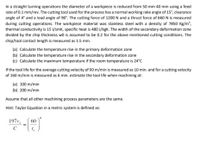
Elements Of Electromagnetics
7th Edition
ISBN: 9780190698614
Author: Sadiku, Matthew N. O.
Publisher: Oxford University Press
expand_more
expand_more
format_list_bulleted
Concept explainers
Question

Transcribed Image Text:In a straight turning operations the diameter of a workpiece is reduced from 50 mm 40 mm using a feed
rate of 0.1 mm/rev. The cutting tool used for the process has a normal working rake angle of 15°, clearance
angle of 4° and a lead angle of 90°. The cutting force of 1200N and a thrust force of 660 N is measured
during cutting operations. The workpiece material was stainless steel with a density of 7850 Kg/m³,
thermal conductivity is 15 J/smK, specific heat is 480 J/kgK. The width of the secondary deformation zone
divided by the chip thickness wo is assumed to be 0.2 for the above mentioned cutting conditions. The
chip/tool contact length is measured as 1.5 mm.
(a) Calculate the temperature rise in the primary deformation zone
(b) Calculate the temperature rise in the secondary deformation zone
(c) Calculate the maximum temperature if the room temperature is 24°C
If the tool life for the average cutting velocity of 90 m/min is measured as 10 min. and for a cutting velocity
of 160 m/min is measured as 6 min. estimate the tool life when machining at:
(a) 100 m/min
(b) 200 m/min
Assume that all other machining process parameters are the same.
Hint: Taylor Equation in a metric system is defined as:
197v,
60
C
1,
Expert Solution
This question has been solved!
Explore an expertly crafted, step-by-step solution for a thorough understanding of key concepts.
This is a popular solution
Trending nowThis is a popular solution!
Step by stepSolved in 8 steps

Knowledge Booster
Learn more about
Need a deep-dive on the concept behind this application? Look no further. Learn more about this topic, mechanical-engineering and related others by exploring similar questions and additional content below.Similar questions
- A turning operation is performed on C1008 steel (a ductile steel) using a tool with a nose radius= 1.3 mm. Cutting speed = 61 m/min and feed = 0.27 mm/rev. Compute an estimate of the surface roughness in this operation. (Hint: the ratio of actual to ideal roughness can be read on the figure below) Equations used; Ra Ri Actual Ratio Theoretical 32NR = rai Ri 2.4 2.2 2.0 1.8 1.6 1.4 1.2 1.0 0 Ductile metals Cast irons Free machining alloys. 100 30.5 200 Cutting speed-ft/min 61 Cutting speed - m/min 300 91.5 400 122arrow_forwardA student is performing a turning operation with a workpiece with an initial diameter of 40 mm to produce a 30 mm diameter rod that is 100 mm long. The lathe power is 20 kW and is operating on 85% mechanical efficiency. If the student set the cutting speed to 0.5 m/min and the cutting tool is set to have a rake angle of 5 degrees: a.) What material can we choose for the rod is the coefficient of friction is 0.5? b.) If we select 4130 normalized heat-treated steel for the rod, and coefficient of friction is 0.5, what will the maximum depth of cut we can achieve?arrow_forward
Recommended textbooks for you
 Elements Of ElectromagneticsMechanical EngineeringISBN:9780190698614Author:Sadiku, Matthew N. O.Publisher:Oxford University Press
Elements Of ElectromagneticsMechanical EngineeringISBN:9780190698614Author:Sadiku, Matthew N. O.Publisher:Oxford University Press Mechanics of Materials (10th Edition)Mechanical EngineeringISBN:9780134319650Author:Russell C. HibbelerPublisher:PEARSON
Mechanics of Materials (10th Edition)Mechanical EngineeringISBN:9780134319650Author:Russell C. HibbelerPublisher:PEARSON Thermodynamics: An Engineering ApproachMechanical EngineeringISBN:9781259822674Author:Yunus A. Cengel Dr., Michael A. BolesPublisher:McGraw-Hill Education
Thermodynamics: An Engineering ApproachMechanical EngineeringISBN:9781259822674Author:Yunus A. Cengel Dr., Michael A. BolesPublisher:McGraw-Hill Education Control Systems EngineeringMechanical EngineeringISBN:9781118170519Author:Norman S. NisePublisher:WILEY
Control Systems EngineeringMechanical EngineeringISBN:9781118170519Author:Norman S. NisePublisher:WILEY Mechanics of Materials (MindTap Course List)Mechanical EngineeringISBN:9781337093347Author:Barry J. Goodno, James M. GerePublisher:Cengage Learning
Mechanics of Materials (MindTap Course List)Mechanical EngineeringISBN:9781337093347Author:Barry J. Goodno, James M. GerePublisher:Cengage Learning Engineering Mechanics: StaticsMechanical EngineeringISBN:9781118807330Author:James L. Meriam, L. G. Kraige, J. N. BoltonPublisher:WILEY
Engineering Mechanics: StaticsMechanical EngineeringISBN:9781118807330Author:James L. Meriam, L. G. Kraige, J. N. BoltonPublisher:WILEY

Elements Of Electromagnetics
Mechanical Engineering
ISBN:9780190698614
Author:Sadiku, Matthew N. O.
Publisher:Oxford University Press

Mechanics of Materials (10th Edition)
Mechanical Engineering
ISBN:9780134319650
Author:Russell C. Hibbeler
Publisher:PEARSON

Thermodynamics: An Engineering Approach
Mechanical Engineering
ISBN:9781259822674
Author:Yunus A. Cengel Dr., Michael A. Boles
Publisher:McGraw-Hill Education

Control Systems Engineering
Mechanical Engineering
ISBN:9781118170519
Author:Norman S. Nise
Publisher:WILEY

Mechanics of Materials (MindTap Course List)
Mechanical Engineering
ISBN:9781337093347
Author:Barry J. Goodno, James M. Gere
Publisher:Cengage Learning

Engineering Mechanics: Statics
Mechanical Engineering
ISBN:9781118807330
Author:James L. Meriam, L. G. Kraige, J. N. Bolton
Publisher:WILEY